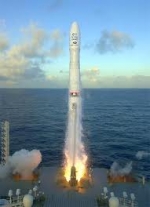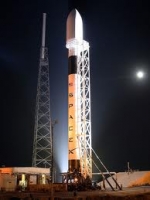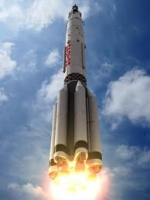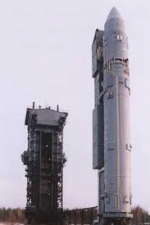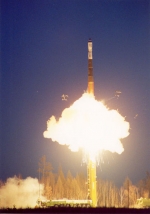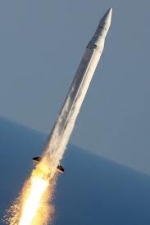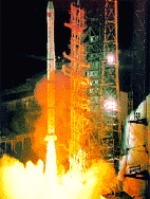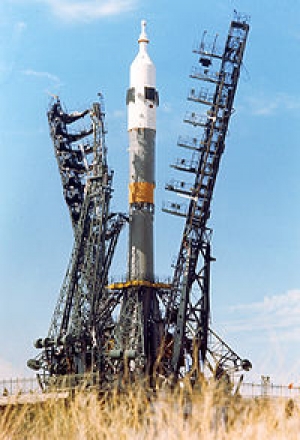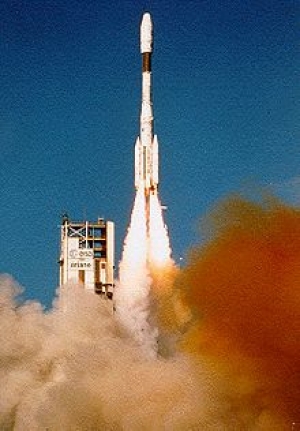Displaying items by tag: rocket
Zenit (rocket family)
Zenit is a family of space launch vehicles designed by the Yuzhnoye Design Bureau of Ukraine.
Zenit was built in the 1980s for two purposes: as a liquid rocket booster for the Energia rocket and, equipped with a second stage, as a stand-alone rocket. Moreover Zenit was planned to take over manned spaceship launches from Soyuz, but these plans were abandoned after the fall of the Soviet Union.
Zenit-3SL is launched by the Sea Launch consortium's floating launch platform in the Pacific Ocean and Zenit-2 is launched from Baikonur Cosmodrome in Kazakhstan.
Falcon 9
Falcon 9 is a rocket-powered spaceflight launch system designed and manufactured by SpaceX, headquartered in Hawthorne, California. Both stages of its two-stage-to-orbit vehicle use liquid oxygen (LOX) and rocket-grade kerosene (RP-1) propellants. The Falcon 9 can lift payloads of 13,150 kilograms to low Earth orbit, and 4,850 kilograms to geostationary transfer orbit, which places the Falcon 9 design in the medium-lift range of launch systems.
The Falcon 9 and Dragon combination won a Commercial Resupply Services (CRS) contract from NASA to resupply the International Space Station under the Commercial Orbital Transportation Services (COTS) program. The first commercial resupply mission to the International Space Station launched on October 7, 2012.
Proton (rocket)
Proton (Прото́н) (formal designation: UR-500) is an expendable launch system used for both commercial and Russian government space launches.
The first Proton rocket was launched in 1965 and the launch system is still in use as of 2012, which makes it one of the most successful heavy boosters in the history of spaceflight. All Protons are built at the Khrunichev plant in Moscow, and then transported for launch to the Baikonur Cosmodrome, where they are brought to the launch pad horizontally and then raised into vertical position for launch.
The launch capacity to low Earth orbit is about 22 tonnes. The geostationary transfer capacity is about 5–6 tonnes.
The commercial launches are marketed by International Launch Services (ILS). In a typical launch of a commercial communications satellite destined for geostationary orbit, a Proton M/Briz-M can place a spacecraft with mass at separation of 4,140 kg into an orbit with an apogee of 35,786 kilometres, a perigee of 6,257 kilometres and an inclination of 19.7°.
Like many Soviet boosters, the names of recurring payloads became associated with their launchers. Thus the moniker "Proton" originates from a series of large scientific Proton satellites, which were among the rocket's first payloads.
Rockot
The Rokot (Russian: Рокот meaning Roar), also transliterated Rockot, is a Russian space launch vehicle that can launch a payload of 1,950 kilograms into a 200 kilometre high Earth orbit with 63° inclination.
It is a derivative of the UR-100N (SS-19 Stiletto) intercontinental ballistic missile (ICBM).
It is supplied and operated by Eurockot Launch Services. The first launches started in the 1990s from Baikonur Cosmodrome out of a silo. Later commercial launches commenced from Plesetsk Cosmodrome using a launch ramp specially rebuilt from one for the Kosmos-3M rocket.
Start-1 rocket
Start-1 is a Russian satellite launch vehicle based on the RT-2PM Topol, a Soviet intercontinental ballistic missile developed by Moscow Institute of Thermal Technology.
The Start-1 launch vehicle derives its name from the Strategic Arms Reduction Treaty (START I) between the United States and the Soviet Union.
The Start-1 rocket is unique amongst launch vehicles in that its launch platform is mobile, allowing for the Start-1 to potentially launch from anywhere. The Start-1 launches from an unmodified Topol Transporter-Erector-Launcher (TEL). The TEL is a massive fourteen-wheeled vehicle, six of which pivot for steering. The launch vehicle is transported and launched inside a mobile Transport and Launch Carrier (TLC) carried by the TEL. The TLC consists of an air-tight composite cylinder that protects the launch vehicle and payload from variations in temperature and humidity. The TLC lays in the middle of the TEL lengthwise and bisects the driver's cab in two.
A version of the Start-1 rocket, simply called Start, was developed in parallel with the Start-1 program. Start differed from Start-1 by using the second stage of the Start-1 twice, giving it a total of five stages. With the extra stage, payload to LEO was increased to 850 kg.
Naro-1 (KSLV-1)
Naro-1 is South Korea's first carrier rocket, which made its maiden flight on 25 August 2009. It is built by KARI, the national space agency of South Korea, and Korean Air, with the first stage provided by Khrunichev (Russia). It was twice launched from the country's new spaceport, the Naro Space Center, but both launches ended in failure.
Its previous name was "Korea Space Launch Vehicle" or KSLV. The official name of the first KSLV rocket, KSLV-I, is Naro, which is the name of the region in which Naro Space Center is located.
The Naro-1 rocket is based on the Universal Rocket Module, the first stage of the Russian Angara rocket, combined with a solid-fueled second stage built by South Korea.
Energia Launcher
Energia (Russian: Энергия, Energiya, "Energy") was a Soviet rocket that was designed by NPO Energia to serve as a heavy-lift expendable launch system as well as a booster for the Buran spacecraft.
The Energia used four strap-on boosters powered by a four-nozzle RD-170 engine burning with kerosene/LOX, and a central core stage with 4 one-chamber RD-0120 (11D122) engines fueled with liquid hydrogen/LOX.
The launch system had two functionally different operational variants: Energia-Polyus, the initial test configuration, in which the Polyus system was used as a final stage to put the payload into orbit, and Energia-Buran, in which the Buran spacecraft was the payload and the source of the orbit insertion impulse.
The rocket had the capacity to place about 100 metric tons in Low Earth orbit, up to 20 t to the geostationary orbit and up to 32 t to the lunar mission trajectory.
Long March rocket
A Long March rocket (simplified Chinese: 长征系列运载火箭; traditional Chinese: 長征系列運載火箭; pinyin: Chángzhēng xìliè yùnzài huǒjiàn) or Chang Zheng rocket as in Chinese pinyin is any rocket in a family of expendable launch systems operated by the People's Republic of China. Development and design falls under the auspices of theChina Academy of Launch Vehicle Technology. In English, the rockets are abbreviated as LM- for export and CZ- within China, as "Chang Zheng" means "Long March" in Chinese pinyin. The rockets are named after the Long March of Chinese communist history.
Soyuz rocket
Soyuz is a family of expendable launch systems developed by OKB-1, and manufactured by TsSKB-Progress in Samara, Russia.
The launch services are commercialised by the company Starsem.
The Soyuz launch vehicle family has provided reliable and efficient launch services since the birth of the space program. Vehicles in this family, which have launched both the first satellite and first man into space, have been credited with more than 1000 launches. Today, this vehicle is used for manned and unmanned flights to the International Space Station and commercial launches.

